Are you looking for the best classical guitar ‘under $500’? Then, you’re in the right place.
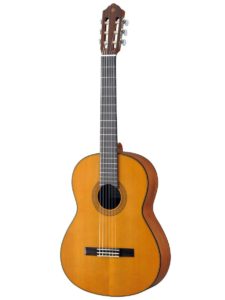
A classical guitar can be a beautiful thing. From the nylon strings to the often intricate design and craftsmanship, classical guitars are both a blast from the past and a way to bring pure, crisp acoustic sound to life.
Classical guitars deliver a clean, natural sound, and they’re frequently a bit easier to pick up for beginners, thanks to the softer strings.
And yes, sometimes they can be costly. Still, you don’t necessarily have to break the bank in your quest to become the next Andrés Segovia.
Best Classical Guitars Under $500 – Comparison Table:
| Image | Model | Price |
|---|---|---|
 | Yamaha CG122MCH (Editor's Choice) | Check Price |
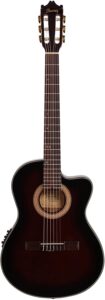 | Ibanez GA35TCE | Check Price |
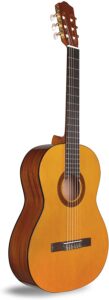 | Cordoba C1 | Check Price |
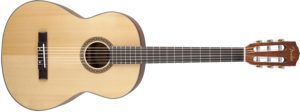 | Fender FC-100 | Check Price |
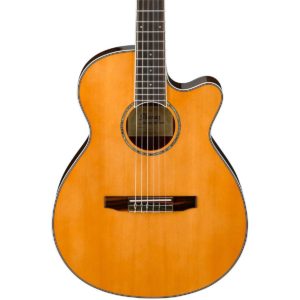 | Ibanez AEG10NII | Check Price |
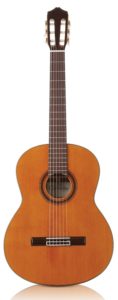 | Cordoba C7 | Check Price |
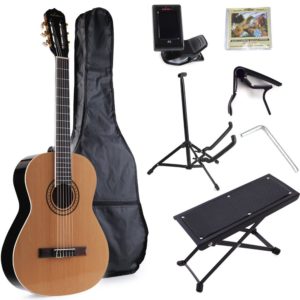 | ADM ADMJC613-YW | Check Price |
Yamaha CG122MCH Classical Guitar (Editor’s Choice)
The CG122MCH may be the best guitar at its price point. It’s not a cheap toy you can pick up at Walmart for 100 bucks, but it’s not going to cost you thousands of dollars. Checking in around the low-200’s, this guitar brings tremendous sound at an excellent price.
It would be suitable for a beginner or novice because it comes with soft tension strings, which are easy to play with, and it’s straightforward to get high-quality sound from the guitar without trying hard.
The cedar top delivers the lovely warm tone you come to expect from acoustic and classical guitars, and it resonates up and down the fretboard and on all six strings.
The one thing you may notice is that the actual quality of the finish isn’t up to par with more expensive guitars, but for the price, this guitar is tough to beat.
Positives
- Cedar top
- 3-ply neck construction
- Rosewood fingerboard and bridge
Negatives
- The matte wood finish isn’t high quality
- It may be prone to cracking or warping in the body. However, the neck should be acceptable due to 3-ply.
Ibanez GA35TCE
The comfortable guitar fits every music enthusiast as it is small and slender. This typical guitar is for all. The sides and back are made from wood. The co-pickups and a preamp system combination take it to another new level.
It has been a favorite among performers since the start of modern American music. This one is perfect when you do not want to add a burden to your pocket and need a budget-friendly instrument. Instead, you can enjoy an authentic tone with a little edge classic sound.
This guitar is made for beginners as well as experienced players. You will love this affordable acoustic guitar without thinking about damage. This guitar sounds excellent, and its natural sound makes it a perfect campfire guitar.
It is the perfect amalgamation of modern and traditional styles. If you search for a varied and rich tone, then you can go with this classical guitar. Enjoy a variety of music and guitar-playing techniques. Singing highs and clear mids are perfectly balanced. This is one of the best guitars on the market.
Pros
- Slimline design
- Comfort to play
- A built-in tuner is great
Cons
- Lightweight, so it lacks punch
Cordoba C1
This full-size guitar comes with a shiny PU finish. If you are a novice who is new to the guitar world, this is adequate for you. The neck has a lightweight truss rod that makes the neck angle adjustment easy.
The hardware and building are stunning. You will love the worthy warm tone, which is the quality of Cordoba. This incorporates all the features that the brand has experienced over many years.
If you are serious about instruments, this is a perfect guitar. This is an excellent place to begin your classical music journey with comfortable nylon strings. It is made perfectly, and the guitar remains in tuning. It comes with a gig bag. The brand has a specialization in producing string guitars.
The brand has received several awards for innovative guitar design. As a result, you can expect superb sound and high output.
The brand tries to impress every music enthusiast without spending much. The foundation of the brand lies in the inspiring sound of guitar. Hence, it is packed with a high-end feel and classic style.
Pros
- Quality control
- Great for price
- Well made for beginners
Cons
- It takes time to get used to nylon strings
Fender FC-100 Classical Guitar
The Fender FC-100 is a great beginner guitar that you can find for close to 150 dollars, which means it’s a tremendous value for a classical. In addition, the thinner nut width makes the guitar easier to play, especially for beginners or people with smaller hands, and you can say the same thing for the nylon, which is easy and soft on the fingers.
The spruce top will give you a nice tone and the “ring” that people are looking for acoustic and classical guitars. You’ll be able to strum it once and hear it reverberate afterward, thanks to the top and the mahogany back and side pieces. This guitar’s size is perfect for beginners because it’s not huge, but if you’re someone who has big hands, it may be a bit too small.
It is an excellent fit for someone just looking to learn guitar and wants to start with a classical.
Positives
- Thinner nut width (1.73 inches)
- Fender strap, electric tuner, and gig bag included
- Resonant spruce top
Negatives
- A bit on the smaller side, so people with big hands or non-beginners may feel a bit cramped on the fretboard
- Lower strings can be dull
Ibanez AEG10NII Classical Guitar
This guitar starts in the mid-200’s so you’re going to have to pay a bit more, but it’s well worth the price. First of all, it has preamps onboard as well as a tuner, so you’ll be able to plug in and play. Again, that is usually important for gigging musicians, but if you want to play at home or in a small venue with a mic giving you sound, it may not be as big of a deal.
It’s a compact guitar that’s very easy to play — especially if you want to do some fingerpicking. It gives out a great tone both unplugged and through an amp, and it looks as good as it sounds. It has a nice finish, and the addition of the onboard tuner will allow you to make sure that it’s always playing in perfect tune.
Look good, sound good. For a pretty reasonable price, this classical guitar has two essential qualities.
Positives
- Preamp with onboard tuner
- OutputRosewood Bridge
- Mahogany Body
Negatives
- May sound “cheap” to the discerning ear. This is a negative for people looking for concert-quality sound out of their guitar, and if that’s the case, it’s probably best to spend a bit more money.
Cordoba C7 Classical Guitar
The C7 is right near the top of our 500 dollar budget, but there’s a reason why. It’s a high-quality classical guitar made with a cedar top and rosewood everywhere else. It features what they call a “fan bracing pattern,” which means it will be louder and have a more defined tone because the soundboard has more room and area to respond to what you’re doing on the strings. The tone of this guitar is one of its best qualities.
The frets are a bit wider, so if you’ve got bigger fingers or aren’t a beginner, this guitar will likely be very comfortable for you. In addition, you’re going to get a great sound and incredible tone that someone could mistake for a much more expensive guitar. So if you’re on a budget or don’t want to break the bank by buying a truly classic classical guitar, the Cordoba C7 is a solid option.
There have been some complaints online about the saddle being loose or even falling off, so that’s something to watch if you’ve got attention to detail and like to fiddle around with your machinery.
Positives
- Cedar Top
- Rosewood back, sides, bridge, and fingerboard
- Includes gig bag
- High gloss finish
Negatives
- Upper frets may buzz a bit due to high action
- Potentially loose saddle
ADM ADMJC613-YW Classical Guitar
This guitar is the cheapest on our list, checking in under 100 dollars. It’s a good beginner guitar because they can mess around with it, it comes with a ton of stuff to help the beginner get started, and it looks a bit fancier than it is. For being as cheap as it is, the ADMJC613-YW has nice, loud acoustics.
It’s not going to confuse anybody for a classical guitar worth thousands, but for what it is, it gets the job done. But, again, this is a beginner guitar.
Positives
- Spruce top and decorative binding
- Rosewood fingerboard and bridge
- Gold hardware
- Dual-action truss rod
- Includes nylon strings (plus extras), footstool, stand, CAPO, and tuner
Negatives
- Soft case
- Wide neck
- Beginner guitar
How to Find the Best Classical Guitar
With that in mind, here’s a guide to help you find the best classical guitar for under 500 dollars.
Size and Shape
When buying an acoustic guitar, which is usually bigger than its electric brethren, you have to have a sense of yourself. Guitars come in all shapes and sizes, and that’s for two reasons.
- Different shapes and sizes mean different tones and sounds.
- Different shapes and sizes for different people
If you’re a small-bodied person with small arms and hands, perhaps you shouldn’t go out and buy the biggest hollow body you can find. Remember, you want this to sit on your lap comfortably, so you don’t want it to be too big. You also want to reach up and down the fretboard, so make sure you can reach.
If you’re a bigger person, you don’t want to cramp your style by having to curl in on yourself to play your guitar. So get a bigger-bodied guitar and rock out.
There’s also a skill level to consider. Veteran guitar players have spent years stretching, bending, hammering, and pulling their fingers and hands. Thus a bigger fretboard with more room to cover between strings isn’t a huge deal. On the other hand, beginners will struggle with thicker, larger fretboards because they deal with the opposite mentioned above.
It takes some time to figure out how to line things up on the fretboard, press down where you need to, and do so with enough strength to have it sound good — especially if you’re playing chords.
The size and shape of your guitar are vital to your long-term ability to play it, so don’t overlook it.
Playability
How does the guitar play? No, we don’t mean, “can you play the guitar?” That’s an entirely different article.
What we mean is: Literally, how does it play?
If you can, give the guitar a whirl and check out its features. For example, how do the strings feel? Do you have to press down too hard to get the tone you’re looking for, or are the strings too loose for your liking? Of course, you can change strings, but generally, a guitar will hold any string the same way based on the nuts’ size and tightness on the bottom and the tuners’ quality.
With that in mind, check out those tuners. If they’re so tight that you’re going to have to fight to tune up your guitar? On the plus side, it may not fall out of tune as much. On the other hand, if they’re too loose, you will have to check up on your tune constantly, so look for a middle ground.
Feel out the fretboard for any bumps, cracks, dips – anything that can throw you or the quality of your music off. Also, consider that the guitar’s body can play a huge role in what it sounds like, and that includes what it’s made of. Different woods produce different tones, and generally, higher quality material produces higher quality sound.
Listen to the tone and “ring” of the guitar. The acoustics’ tone, volume, and lasting ring come from the soundhole on acoustic and classical guitars. Most are pretty classically shaped, but that’s not always the case, so that’s something else to consider.
Harmonics
A great way to test the overall quality, pickup, and tone of a classical guitar is to play a quick round of harmonics. First, lightly touch the strings on the fifth, seventh, 12th, and 19th frets. Don’t push down on them to create the full note, but lightly press and then pluck with your other hand.
The notes should ring out and sound, well, harmonic. All guitars will do this if strung correctly but test different strings out to check for quality.
That will give you a sense of the guitar as a whole. You’ll get a good feel for the strings’ action, how tense or loose it plays, and how the soundhole reverberates and amplifies your sound.
Electric Capabilities
It doesn’t matter for many classical guitar players, but some want to plug in and play through an amp or over a set of speakers – especially if they’re playing a gig.
Not all acoustic guitars and especially not all classical guitars are made with electrical plugins, but some are. So if that’s important to you as a classical guitar player, you best make sure that your guitar can plugin.
High-quality electric-acoustic guitars will have onboard preamps, perhaps an onboard equalizer, and many have onboard tuners as well. Having a tuner actually in the guitar is a huge plus because you can always make sure that your in-tune saves you from carrying around an electric tuner at all times.
The Best Classical Guitar Under $500: Our Verdict
You don’t have to spend thousands of dollars to find a good classical guitar. Concert musicians or enthusiasts may want to stay away from this range and build up to something bigger. Still, if you’re a beginner or simply a hobby classical guitar player, there’s not much reason to spend over 500 dollars.
At this range, you’re still getting a quality instrument, and in some cases, it’s made some very impressive material. Tone won’t be a problem, and in at least one of the guitars above, you can plugin and play.
With that in mind, in our opinion, the best classical guitar under 500 is the Yamaha CG122MCH.
It will satisfy both beginners and serious classical guitar players with their tone, sound, and quality. Moreover, it’s not too cheap, and it’s not too expensive, which makes it the best classical guitar for under 500 dollars on this list.